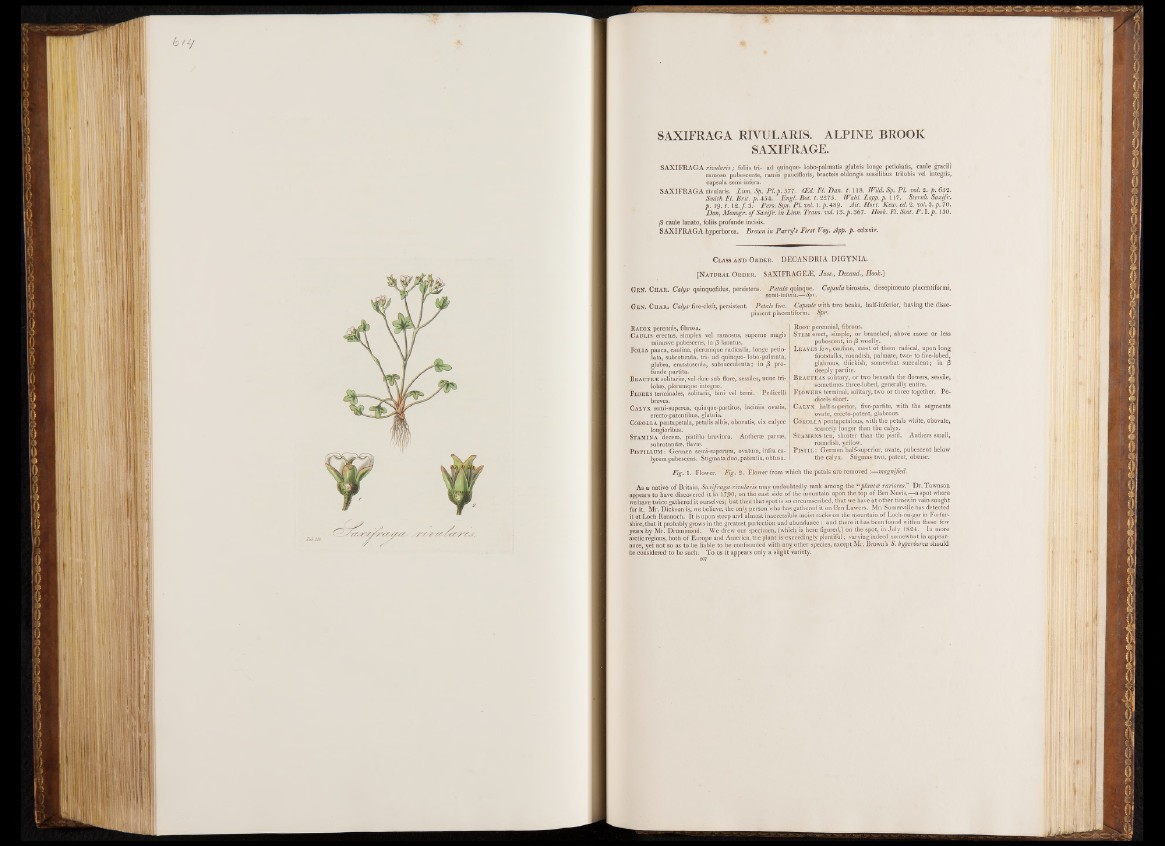
SAXIFRAGA RIYULARIS. ALPINE BROOK
SAXIFRAGE.
SAXIFRAGA rivularis; foliis tri- ad quinque- lobo-palmatis glabris longe petiolatis, caule gracili
ramoso pubescente, ratrais paucifloris, bracteis oblongis sessilibus trilobis vei integris,
capsula semi-infera.
SAXIFRAGA rivularis. L im . Sp. PI.p. 577. (Ed. Fl. Dan. 1. 1 18 . Wild. Sp. PI. vol. 2. p. 652.
Smith Fl. Brit. p. 454. Engl. Bot. t. 2275. Wahl. Lapp. p. 117. Sternb. Saxifr.
p . 1 9 .1. 12.ƒ. 3.' Fers. Syn. PI. ml. I. /».'489. Ait. Hort. Kew. ed. 2. ml. 3. p. 70.
Don, Monogr. o f Saxifr. in L im . Trans, ml. 13. p . 367. Hook. Fl. Scot. P . I. p . 130.
ß caule lanato, foliis profunde incisis.
SAXIFRAGA hyperborea. Brown in Parry's First Voy. App. p . cclxxiv.
Class and Order. DECANDRIA DIGYNIA.
[Natural Order. SAXIFRAGES, Juss., Decand., Hook.]
GeN. Char. Calyx quinquefidus, persistebs. Petala quinque. Capsula birostris, dissepimento placentiformi,
semi-infera.—Spr.
Gen. Char. Calyx five-cleft, persistent. Petals five. Capsule with two beaks, half-inferior, having the dissepiment
placentiform. Spr.
Radix perennis, fibrosa.
Caulis erectus, simplex vel ramosus, supeme magis
minusve pubescens, in /3 lanatus.
Folia pauca, caulina, plerumque radicalia, longe petio-
lata, subrotunda, tri- ad quinque- lobo-palmata,
glabra, crassiuscula, subsucculenta ; in /3 profonde
partita.
Bracteæ solitariæ, vel duas sub flore, sessiles, nunc tri-
lobæ, plerumque integræ.
Flores terminales, solitarii, bini vel terni. Pedicelli
breves.
Calyx semi-superus, quinque-partitus, laciniis ovalis,-
erecto-patentibus, glabris.
Corolla pentapetala, petalis albis, obovatis, vix calyce
longioribus.
Stamina decern, pistillo breviora. Antheræ parvæ,
subrotundæ, flavoe.
Pistillum : Germen semi-superum, ovatum, infra ca-
lycem pubescens. Stigmata duo, pafentia, obtusa.
Root perennial, fibrous.
Stem erect, simple, or branched, above more or less
pubescent, in [3 woolly.
Leaves few, cauiine, most of them radical, upon long
footstalks, roundish, palmate, two- to five-lobed,
glabrous, thickish, somewhat succulent; in (3
deeply partite.
Bracteas solitary, or two beneath the flowers, sessile,
'sometimes three-lobed, generally entire.
Flowers terminal, solitary, two or three together. Pe-
. -dicels short.
Calyx half-superior, five-partite, with the segments
ovate, erecto-patent, glabrous.
Corolla pentapetalous, with the petals white, obovate,
scarcely longer than the calyx.
Stamens ten, shorter than the pistil. Anthers small,
■ ■' roundish, yellow.
Pistil: Germen half-superior, ovate, pubescent below
the calyx. Stigmas two, patent, obtuse.
F/rr, i. Flower. Fig. 2. Flower from which the petals are removed :—magnified.
As a native of Britain, Saxifraga rivularis may undoubtedly rank among the “ plantce rariores.” Dr. Townson
appears to have discovered it in 1790, on the east side of the mountain upon the top of Ben Nevis,—a spot where
we have twice gathered it ourselves; but then that spot is so circumscribed, that we have at other times in vain sought
for it. Mr. Dickson is, we believe, the only person who has gathered it on Ben Lawers. Mr. Somerville has detected
it at Loch Rannoch. It is upon steep and almost inaccessible moist rocks on the^ mountain of Loch-na-gar in Forfarshire,
that it probably glows in the greatest perfection and abundance : and there it has been found within these few
years by Mr. Drummond. We drew our specimen, (which is here figured,} on the spot, in July 1824. In more
arctic regions, both of Europe and America, the plant is'exceedingly'plentiful ; varying indeed somewhat in appearance,
yet not so as to be liable to be confounded with any other species, except Mr. Brown’s S. hyperborea should
be considered to be such. To us it appears only a slight variety.